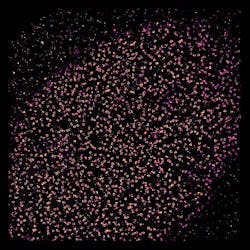Super-res microscopy solves the structure of the nuclear pore
Scientists at the European Molecular Biology Laboratory (EMBL; Heidelberg, Germany) used super-resolution microscopy to solve a decade-long debate about the structure of the nuclear pore complex, which controls access to the genome by acting as a gate into the cellâs nucleus.
Related: Super-res microscopy technique views nanostructures 100 nm wide
The scientists knew the gateâs overall shape from electron tomography studies. And thanks to techniques like x-ray crystallography and single-particle electron microscopy, they knew that the ring which studs the nucleus' wall and controls what passes in and out is formed by 16 or 32 copies of a Y-shaped building block. They also knew that each Y is formed by nine proteins. But how the Ys are arranged to form a ring was up for debate.
âWhen we looked at our images, there was no question: they have to be lying head-to-tail around the hole,â says Anna Szymborska, who carried out the work.
To figure out how the Ys were arranged, the EMBL scientists used fluorescent tags to label a series of points along each of the Yâs arms and tail, and analyzed them under a super-resolution microscope. By combining images from thousands of nuclear pores, they were able to obtain measurements of where each of those points was, in relation to the poreâs center, with precision of less than 1 nm. The result was a rainbow of rings whose order and spacing meant the Y-shaped molecules in the nuclear pore must lie in an orderly circle around the opening, all with the same arm of the Y pointing toward the poreâs center.
Having resolved this decade-old controversy, the scientists intend to delve deeper into the mysteries of the nuclear pore--determining whether the circle of Ys is arranged clockwise or anticlockwise, studying it at different stages of assembly, looking at other parts of the pore, and investigating it in three dimensions.
âThereâs been a lot of interest from other groups,â says Jan Ellenberg, who led the work, âso weâll soon be looking into a number of other molecular puzzles, like the different âmachinesâ that allow a cell to divide, which are also built from hundreds of pieces.â
The work was carried out in collaboration with John Briggsâ group at EMBL, who helped adapt the image averaging algorithms from electron microscopy to super-resolution microscopy, and Volker Cordes at the Max Planck Institute for Biophysical Chemistry in Göttingen, Germany, who provided antibodies and advice.
The work appears in Science; for more information, please visit http://www.sciencemag.org/content/early/2013/07/10/science.1240672.
-----
Follow us on Twitter, 'like' us on Facebook, and join our group on LinkedIn
Subscribe now to BioOptics World magazine; it's free!
